ST elevation myocardial infarction EKG examples
Editor-In-Chief: C. Michael Gibson, M.S., M.D. [1]
For the main page on ST elevation MI, click here.
EKG Examples
Shown below is an EKG demonstrating the evolution of an infarct on the EKG. ST elevation, Q wave formation, T wave inversion, normalization with a persistent Q wave suggest STEMI.

Copyleft image obtained courtesy of ECGpedia, http://en.ecgpedia.org/wiki/File:AMI_evolutie.png
Shown below is an EKG demonstrating ST elevation in lead V1 and aVR; reversal of V6.

Shown below is an EKG demonstrating STEMI changes in the right precordial leads.

Copyleft image obtained courtesy of, http://en.ecgpedia.org/wiki/Main_Page
Shown below is an EKG demonstrating sinus rhythm. The remarkable feature is the poor R wave progression in the V1 and V2 leads and the ST elevation and T wave changes in leads V1 to V4 and I and aVL. The cardiogram suggests an anterior/ lateral MI possibly acute. There is also terminal P wave negativity in V1 suggesting a left atrial abnormality.
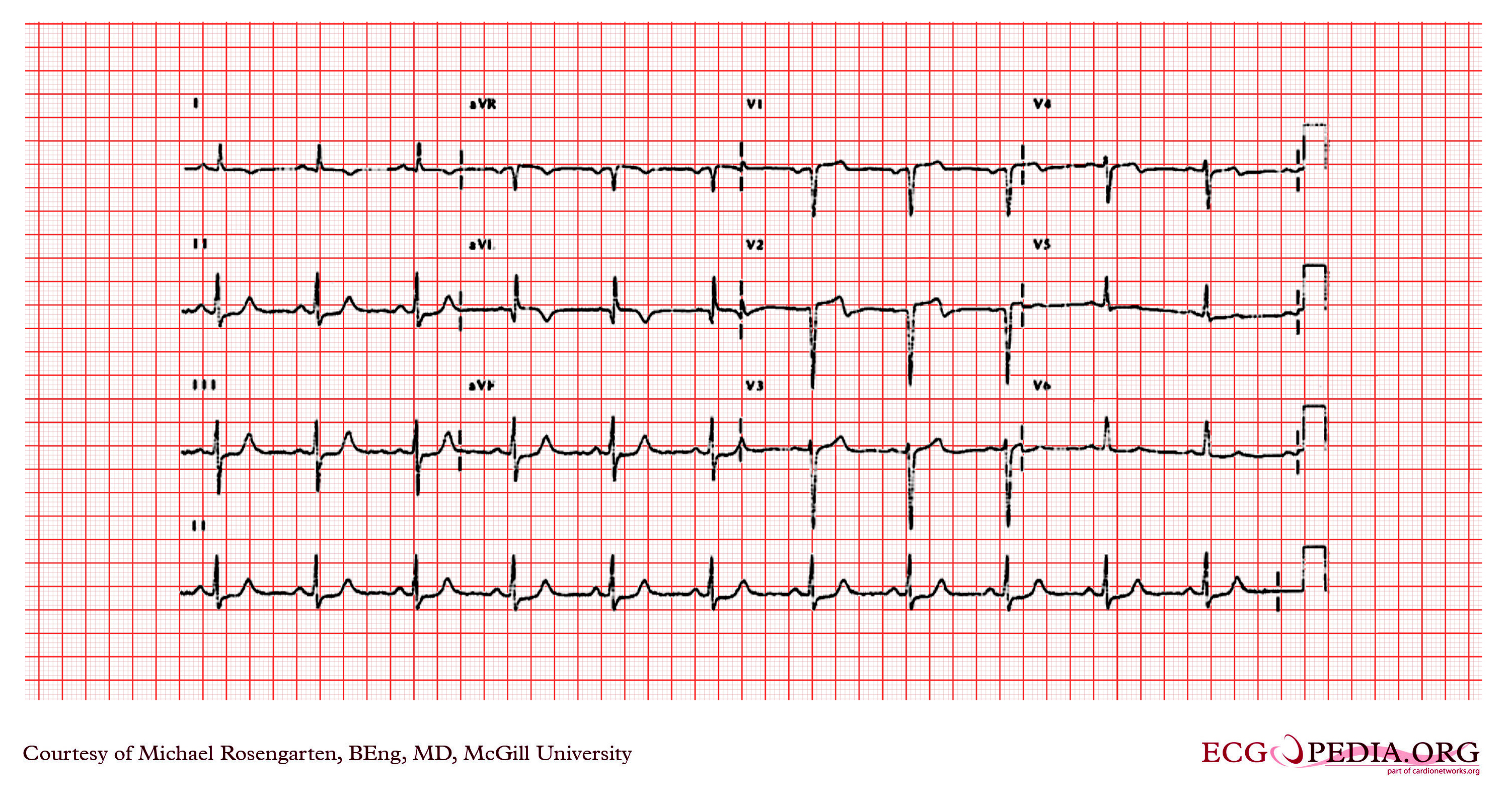
Copyleft image obtained courtesy of, http://en.ecgpedia.org/wiki/File:E209.jpg
Shown below is an EKG illustrating acute inferior MI. ST elevation in theprecordial and limb leads.
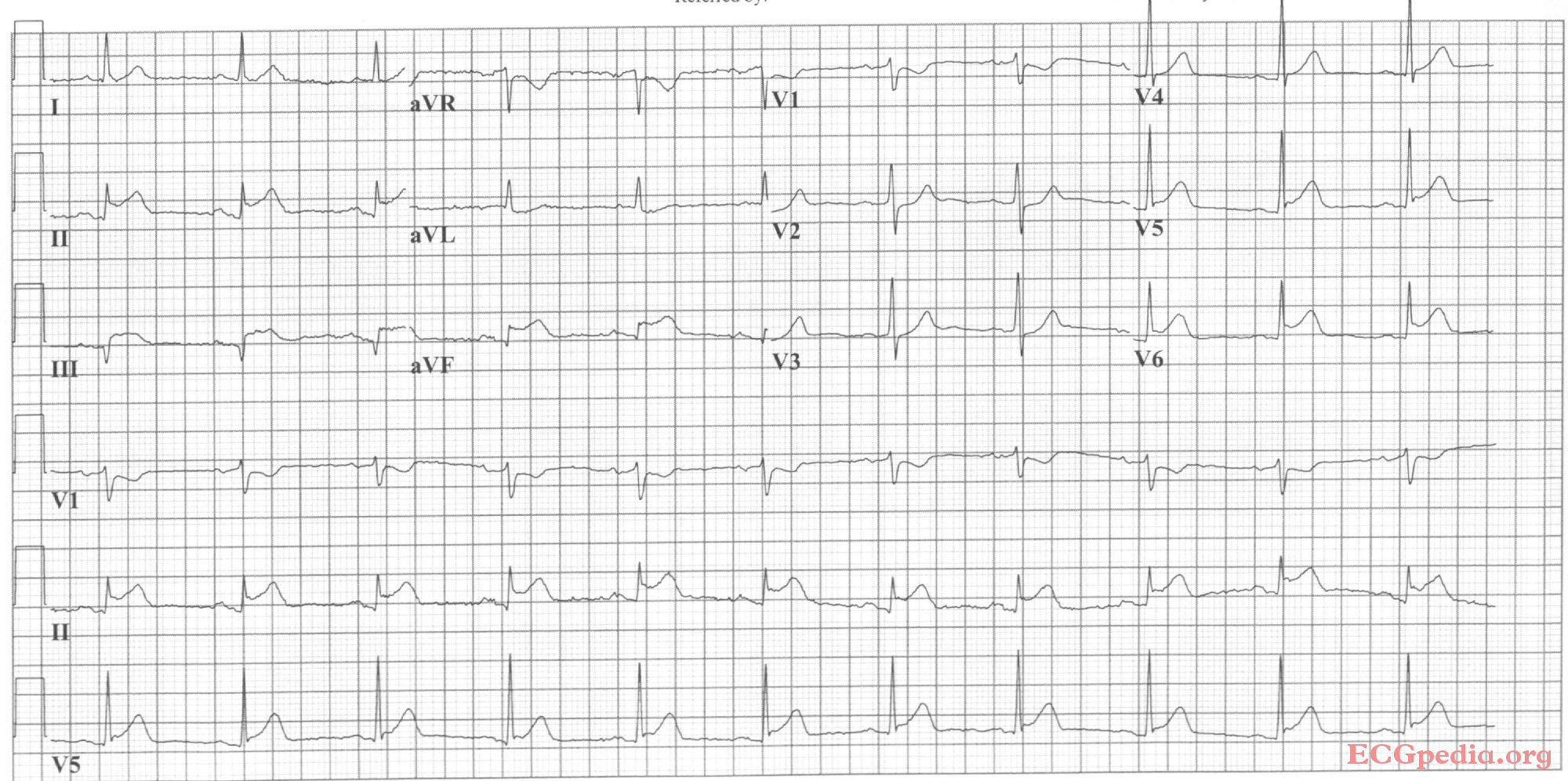
Copyleft image obtained courtesy of, http://en.ecgpedia.org/wiki/Main_Page
Shown below is an EKG with ST elevation in II, III, aVF (in III > II), ST depression in I, aVL, V2. Tall R in V2, otherwise normal QRS morphology. The findings are suggestive of acute posteroinferior MI.
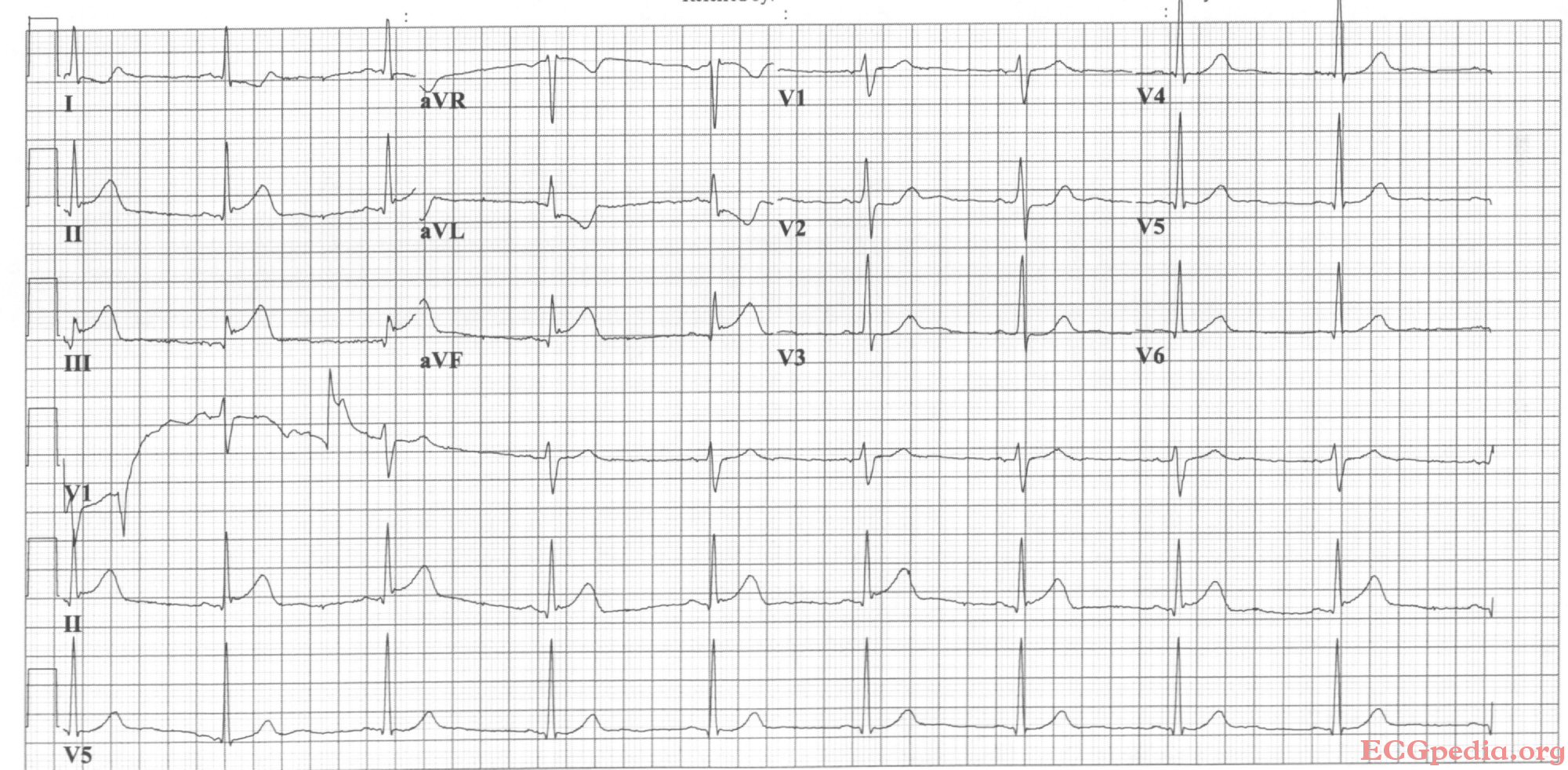
Copyleft image obtained courtesy of, http://en.ecgpedia.org/wiki/Main_Page
Shown below is an EKG demonstrating changes during acute inferior MI depicting ST elevation in leads II, III and aVF.

Copyleft image obtained courtesy of, http://en.ecgpedia.org/wiki/Main_Page
Shown below is an example of EKG demonstrating changes during acute posterolateral MI depicting ST depression in precordial leads V2-V6.

Copyleft image obtained courtesy of, http://en.ecgpedia.org/wiki/Main_Page
Shown below is an EKG with ST depression in V1, V4, tall R in V2. ST elevation in II, III, aVF, V5 and V6.
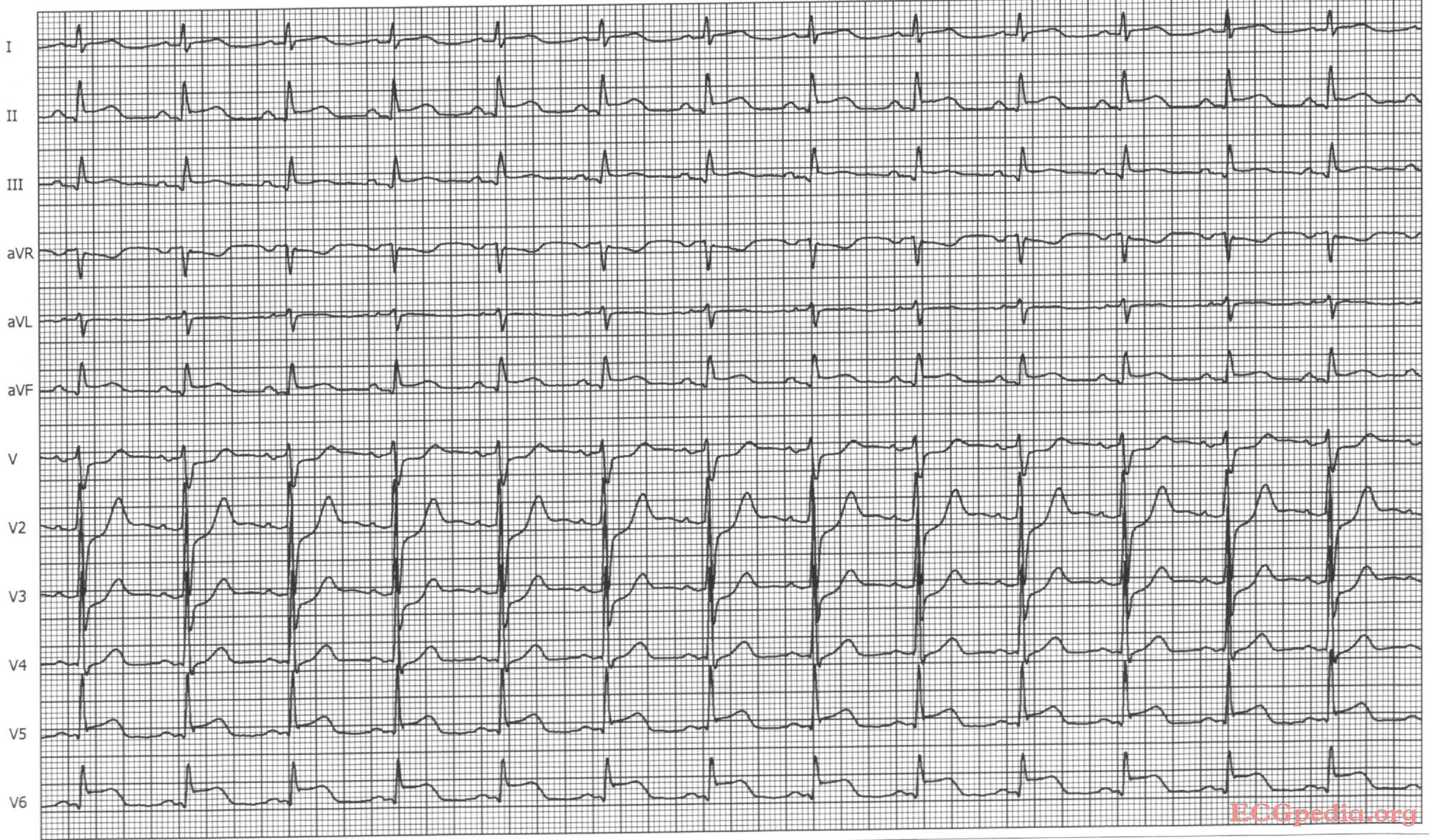
Copyleft image obtained courtesy of, http://en.ecgpedia.org/wiki/Main_Page
Shown below is an EKG demonstrating loss of R waves throughout the anterior wall (V1-V6). QS complexes in V3-V5. ST elevation in V1-V5 with terminal negative T waves.
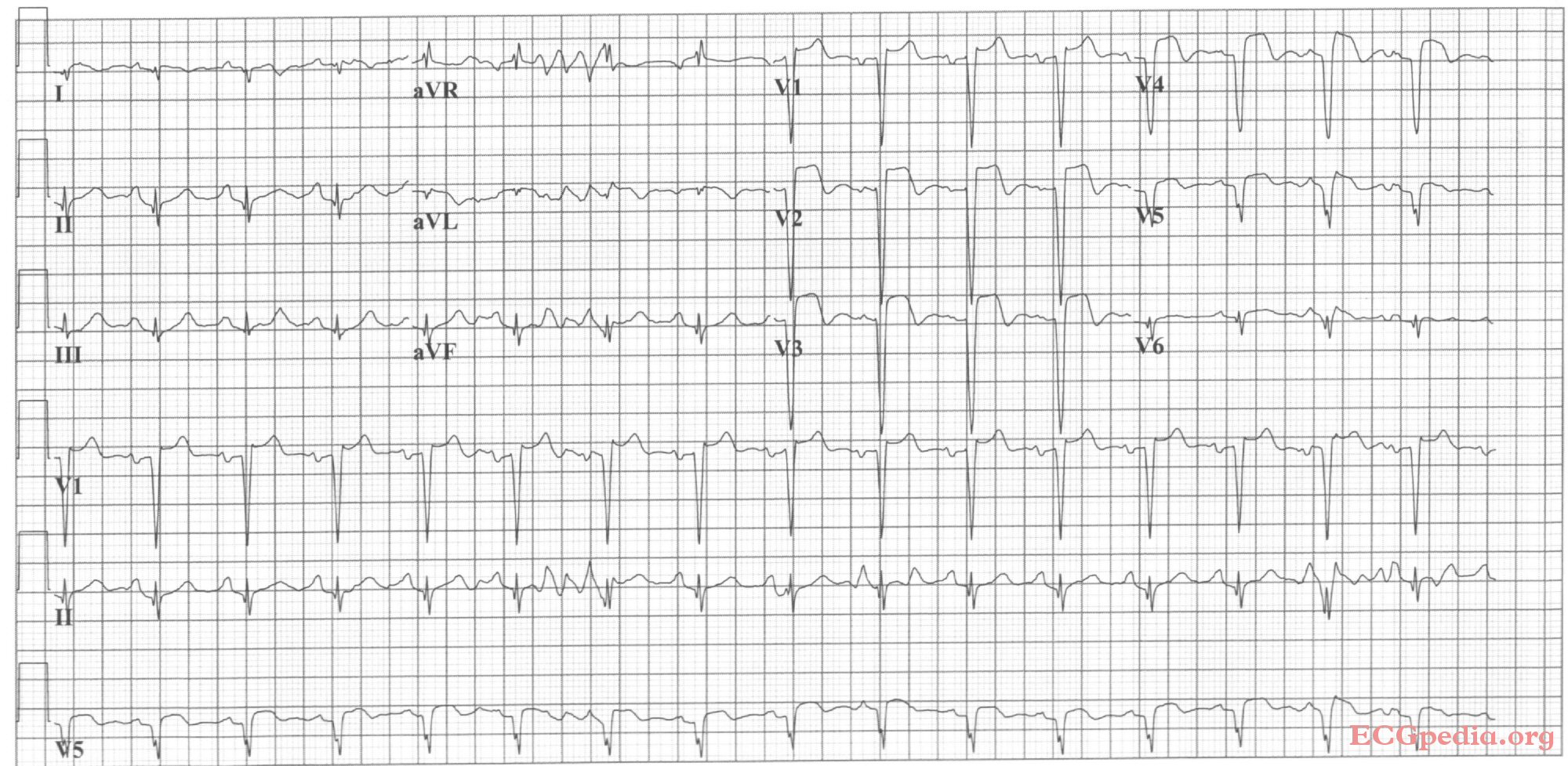
Copyleft image obtained courtesy of, http://en.ecgpedia.org/wiki/Main_Page
Shown below is an EKG with sinus bradycardia with first degree AV block and inferior-posterior-lateral myocardial infarction.

Copyleft image obtained courtesy of, http://en.ecgpedia.org/wiki/Main_Page
Shown below is an EKG depicting sinus bradycardia with inferior-lateral myocardial infarction.

Copyleft image obtained courtesy of, http://en.ecgpedia.org/wiki/Main_Page
Shown below is an EKG demonstrating acute anterior MI. LAD artery occlusion.
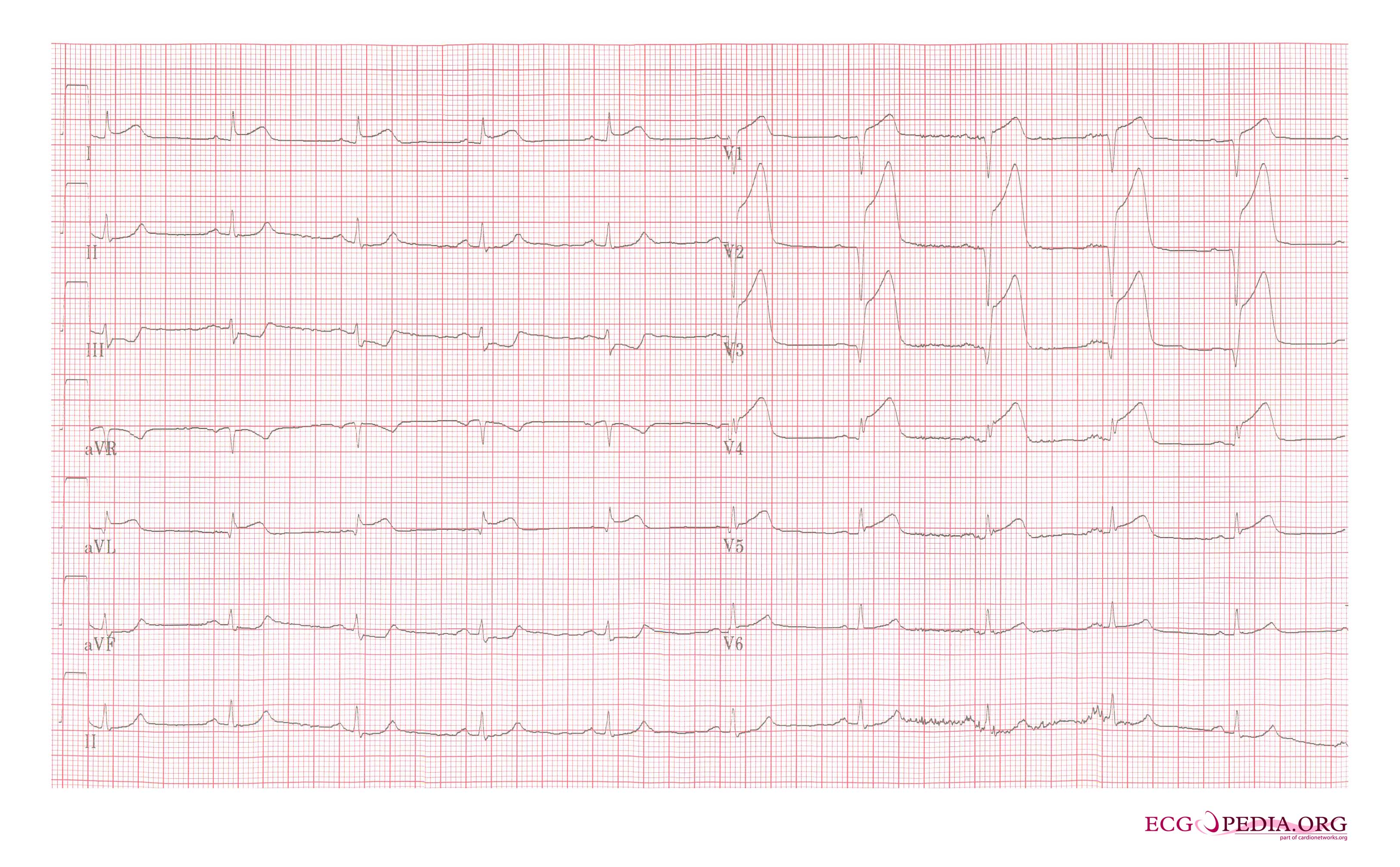
Copyleft image obtained courtesy of, http://en.ecgpedia.org/wiki/Main_Page
Shown below is an EKG showing sinus rhythm with anteroseptal myocardial infarction depicting ST elevation in V1-V6 and in lead I.

Copyleft image obtained courtesy of, http://en.ecgpedia.org/wiki/Main_Page
Shown below is an EKG demonstrating sinus rhythm with left bundle branch block, comparison with an old EKG is mandatory to evaluate whether the LBBB is new (a sign of myocardial infarction) or old.
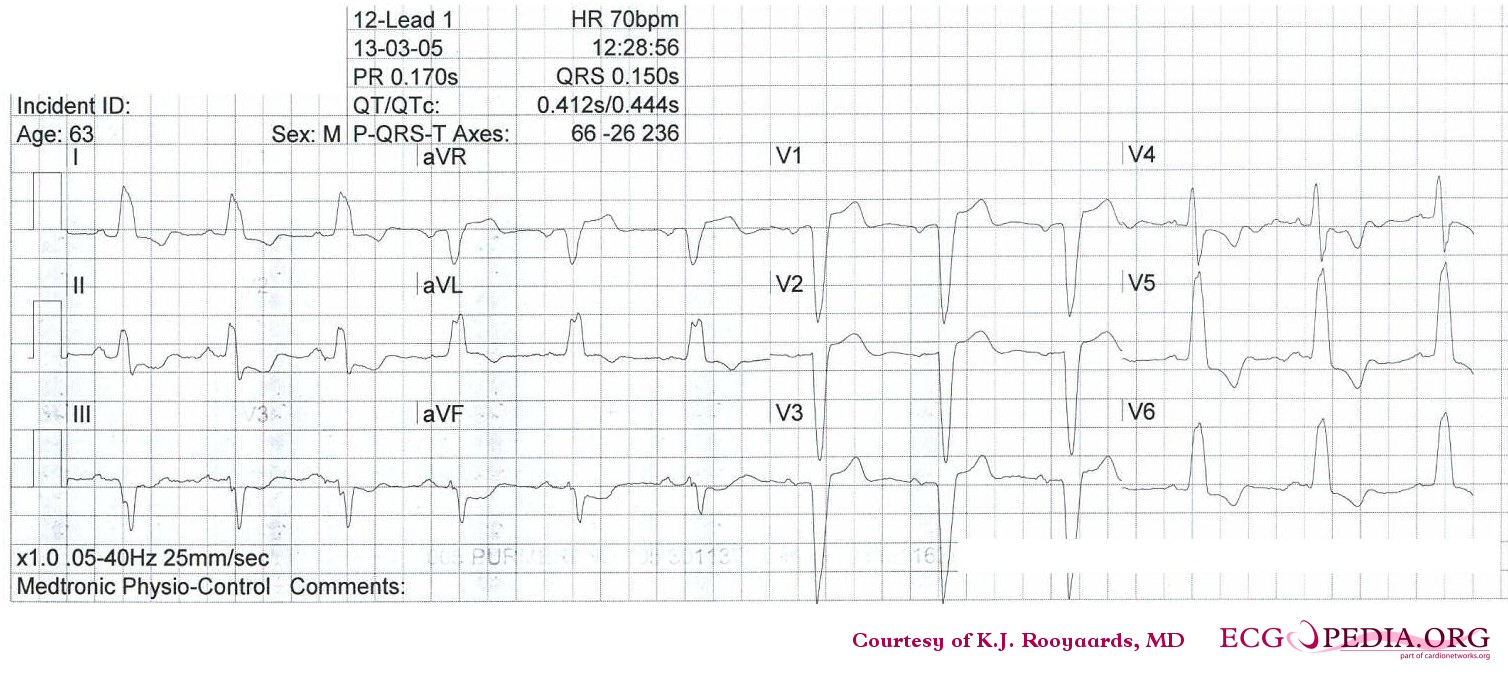
Copyleft image obtained courtesy of, http://en.ecgpedia.org/wiki/Main_Page
Shown below is an EKG illustrating inferior-posterior myocardial infarction with complete AV block and ventricular escape rhythm with RBBB pattern and left axis, followed by sinus rhythm.

Copyleft image obtained courtesy of, http://en.ecgpedia.org/wiki/Main_Page
Shown below is an EKG demonstrating acute anterior myocardial infarction and left anterior hemiblock depicting ST elevation in precordial leads.

Copyleft image obtained courtesy of, http://en.ecgpedia.org/wiki/Main_Page
Shown below is an EKG demonstrating old anterior myocardial infarction and bifascicular block (RBBB and LAHB) as indicated in the anterior chest leads.

Copyleft image obtained courtesy of, http://en.ecgpedia.org/wiki/Main_Page
Shown below is an EKG illustrating acute MI with proximal LAD occlusion depicting ST elevation in anterior precordial leads.

Copyleft image obtained courtesy of, http://en.ecgpedia.org/wiki/Main_Page
Shown below is an EKG demonstrating a 2 days old anterior infarction with Q waves in V1-V4 with persisting ST elevation, a sign of left ventricular aneurysm formation.
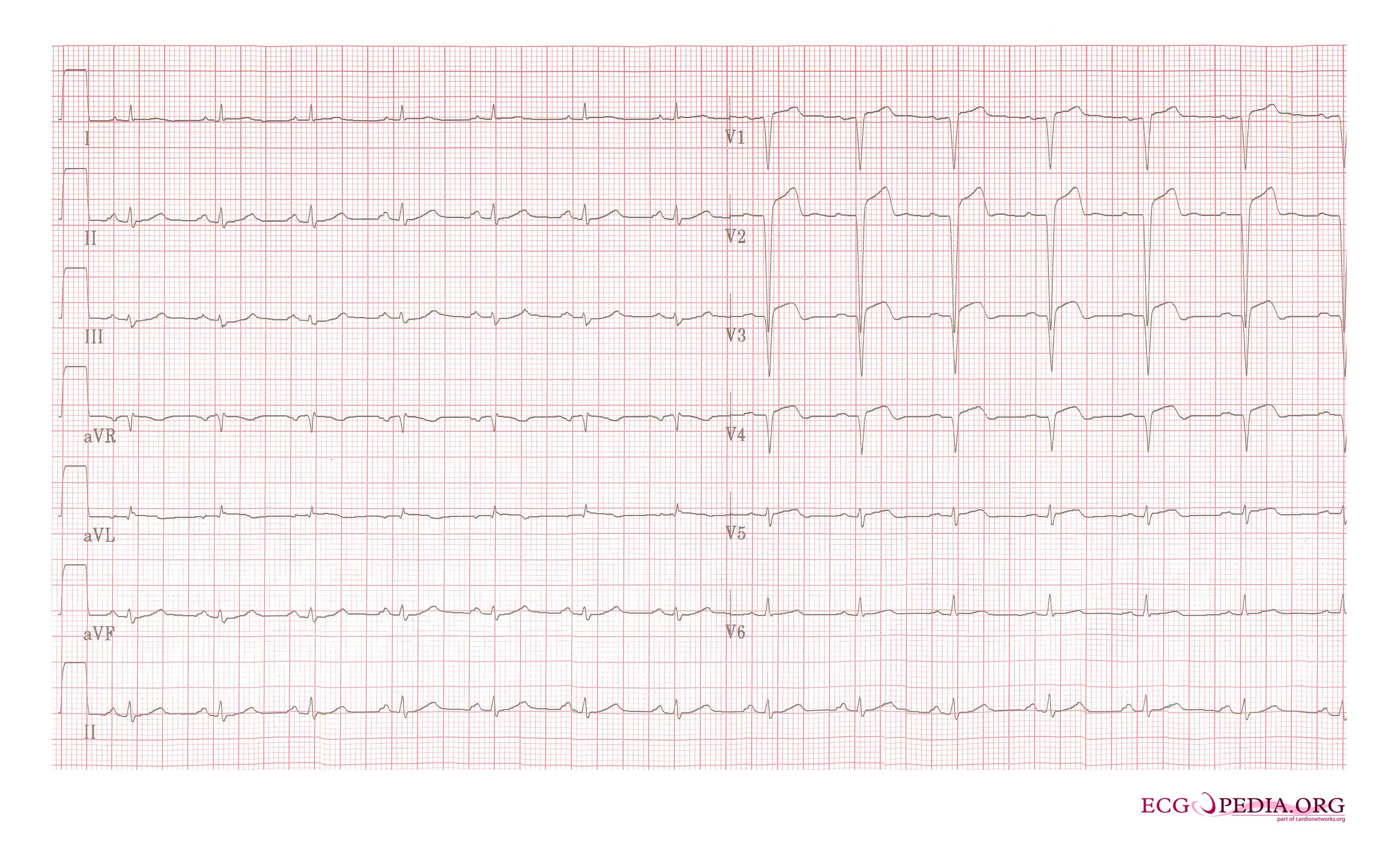
Copyleft image obtained courtesy of, http://en.ecgpedia.org/wiki/Main_Page
Shown below is an EKG demonstrating a 2 weeks old anterior infarction with Q waves in V2-V4 and persisting ST elevation, a sign of left ventricular aneurysm formation.

Copyleft image obtained courtesy of, http://en.ecgpedia.org/wiki/Main_Page
Shown below is an EKG demonstrating a large anterior wall infarction on admission. This image depicts ST elevation in V2-V5 leads.
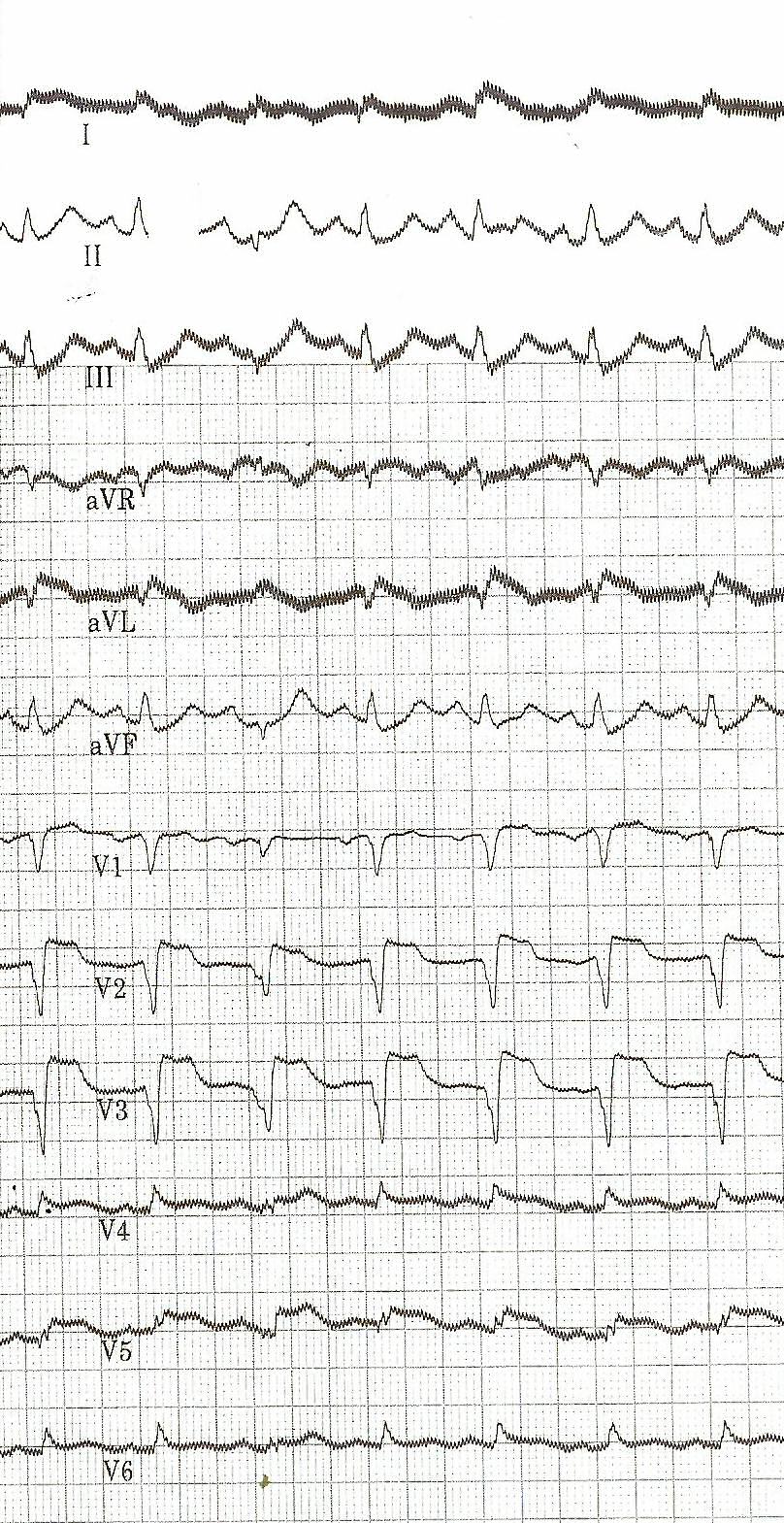
Copyleft image obtained courtesy of, http://en.ecgpedia.org/wiki/Main_Page
Shown below is an EKG demonstrating a trial fibrillation and inferior-posterior myocardial infarction.
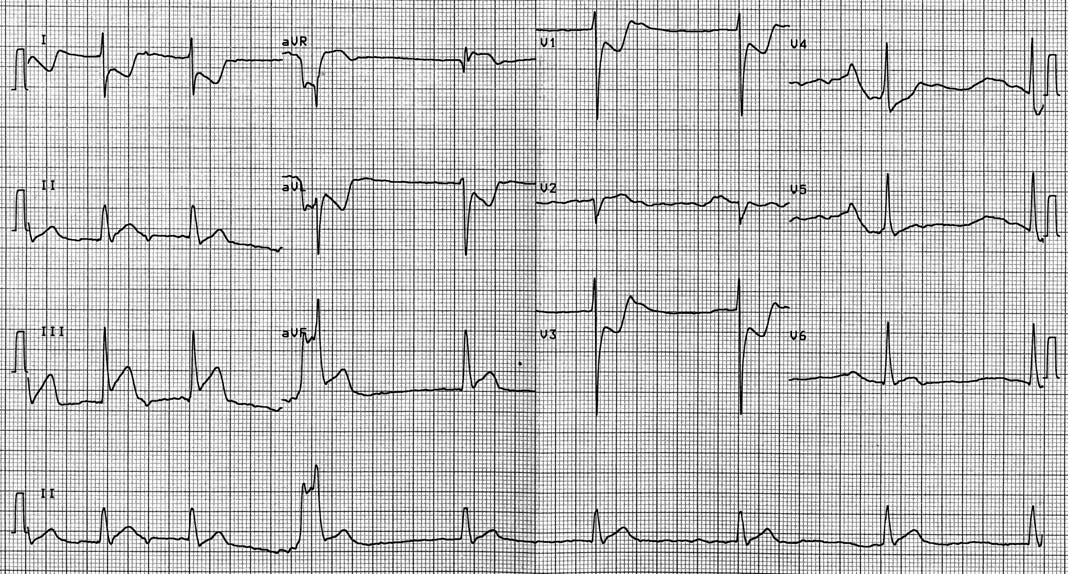
Copyleft image obtained courtesy of, http://en.ecgpedia.org/wiki/Main_Page
Shown below is an EKG demonstrating clear ST elevation in the right precordial leads. A coronary angiography revealed a proximal right coronary artery occlusion.
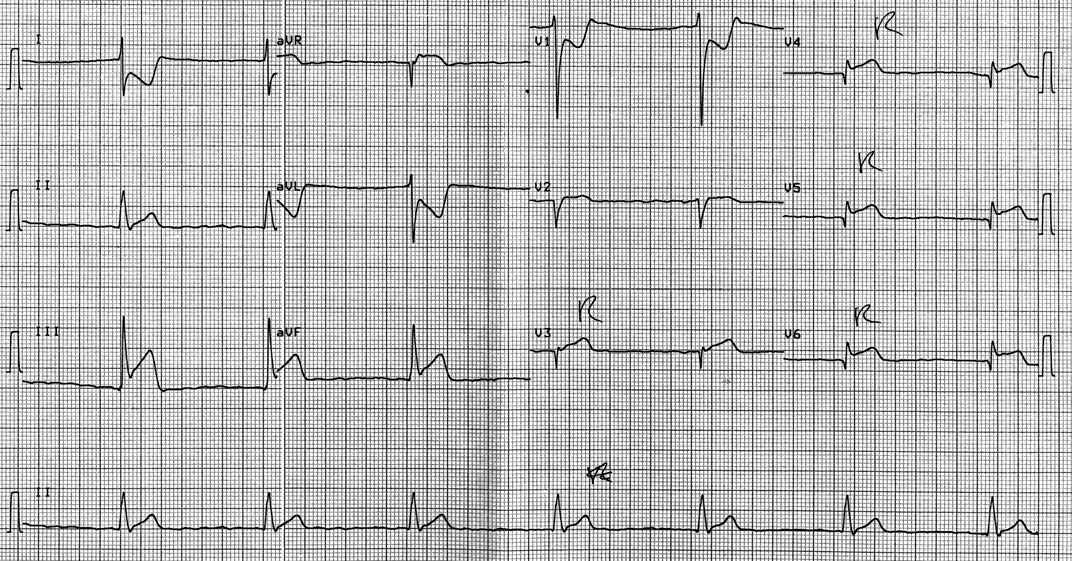
Copyleft image obtained courtesy of, http://en.ecgpedia.org/wiki/Main_Page
Shown below is an EKG demonstrating inferior-posterior-lateral myocardial infarction with a nodal escape rhythm
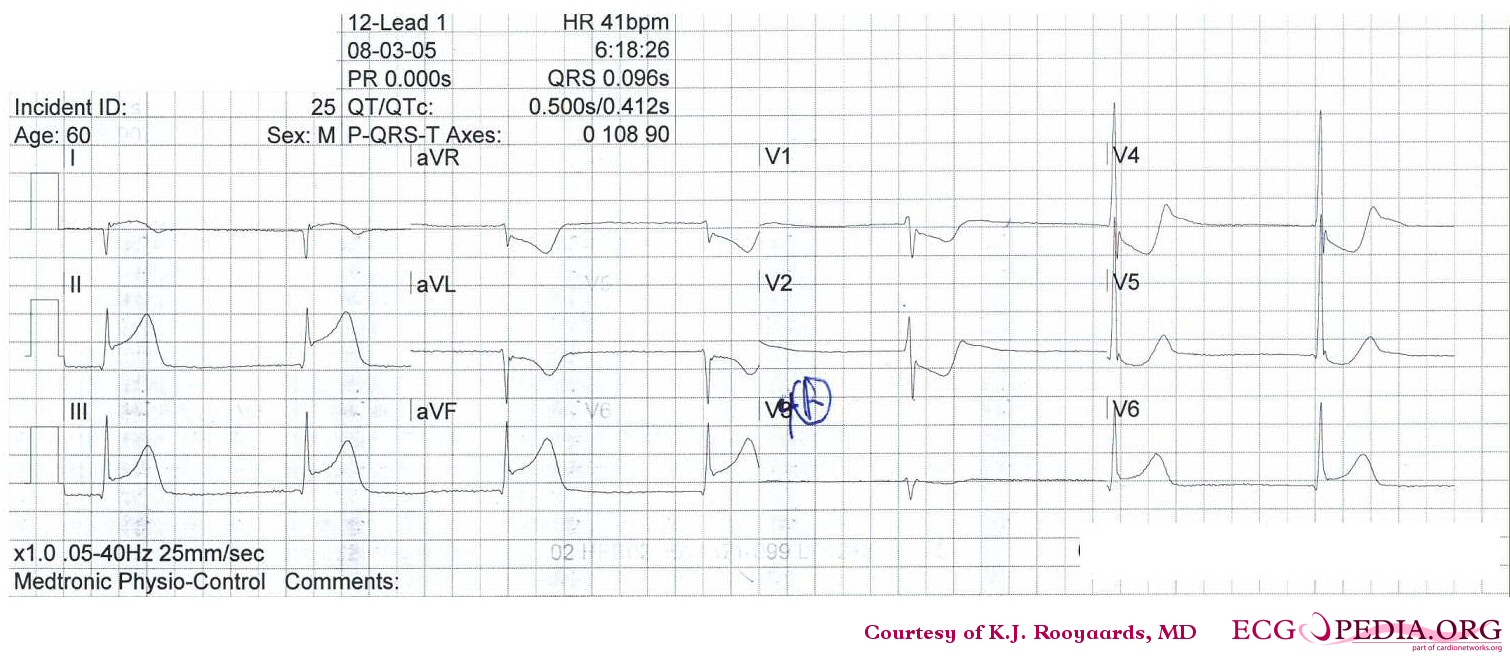
Copyleft image obtained courtesy of, http://en.ecgpedia.org/wiki/Main_Page
Shown below is an EKG demonstrating RBBB and inferior MI. Note to left axis deviation.
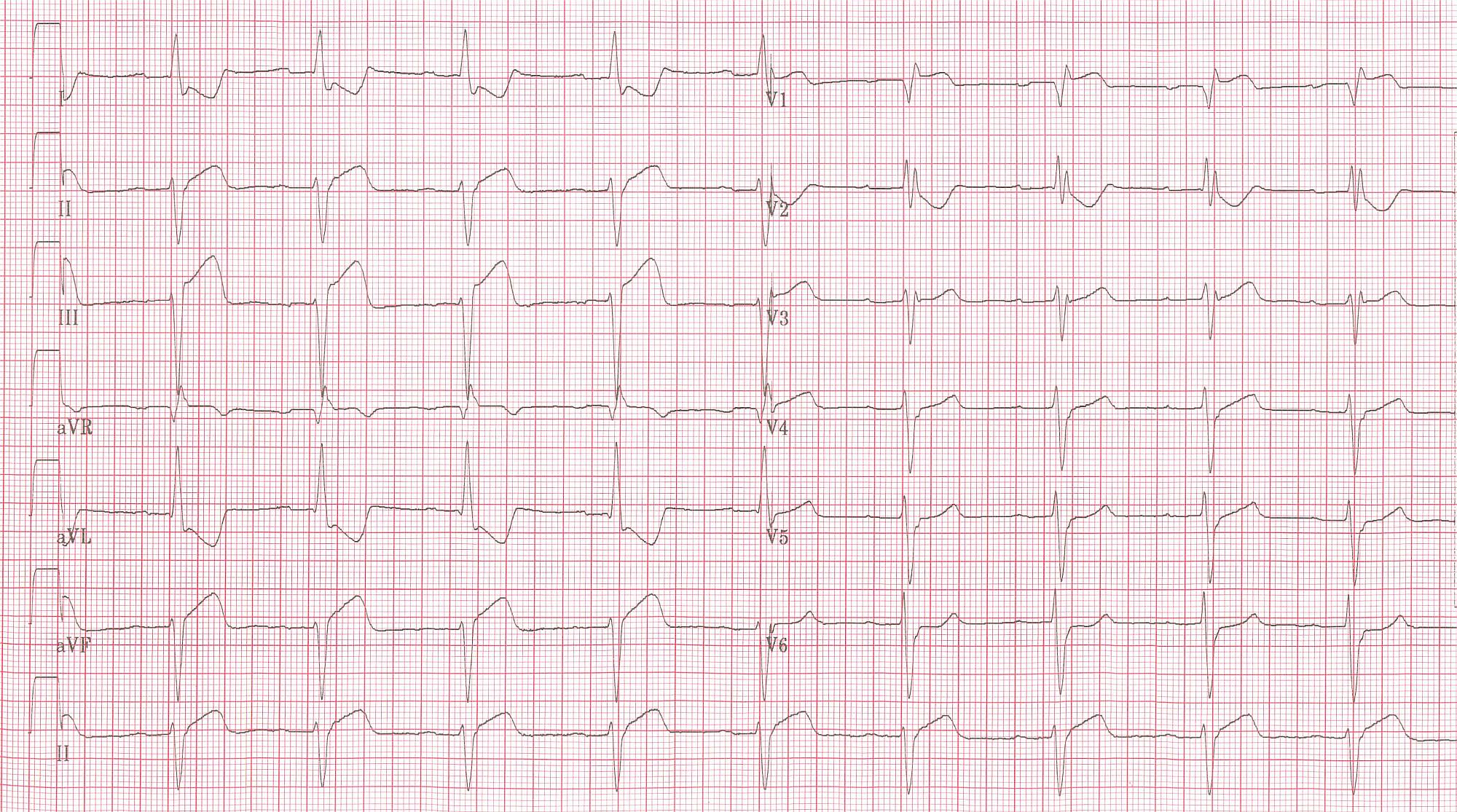
Copyleft image obtained courtesy of, http://en.ecgpedia.org/wiki/Main_Page
Shown below is an example of an EKG demonstrating lead V4R in the same patient with RBBB and inferior MI clearly shows ST elevation.

Copyleft image obtained courtesy of,http://en.ecgpedia.org/wiki/Main_Page
Shown below is an example of an EKG demonstrating cute myocardial infarction in in a patient with a pacemaker and LBBB. Concordant ST elevation in V5-V6 are clearly visible. There is discordant ST segment elevation > 5 mm in lead V3.

Copyleft image obtained courtesy of,http://en.ecgpedia.org/wiki/Main_Page
Shown below is an example of an EKG demonstrating findings in the same patient as in the first example 2 months before the myocardial infarction. Normal LBBB pattern.
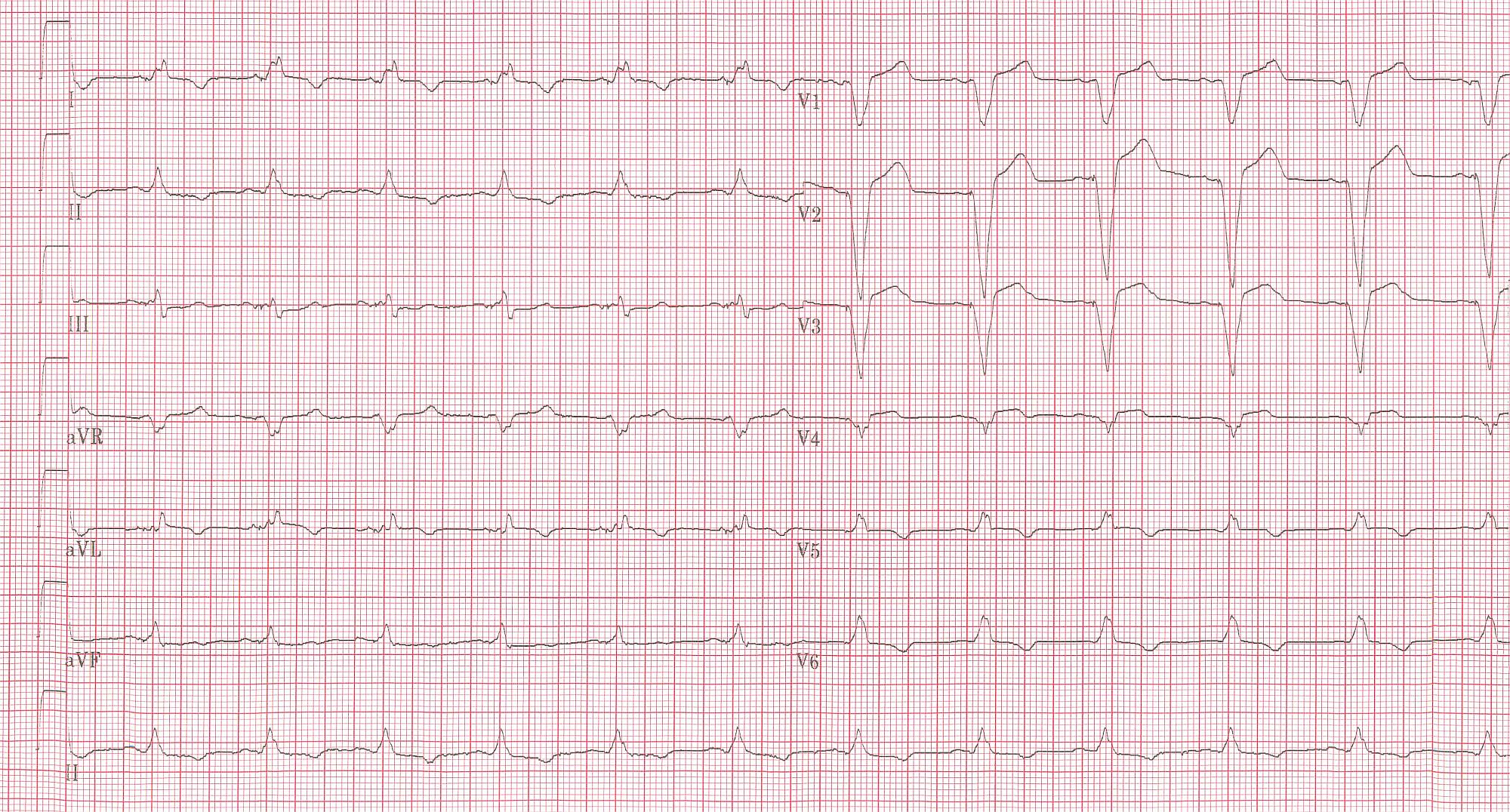
Copyleft image obtained courtesy of,http://en.ecgpedia.org/wiki/Main_Page
Shown below is an example of an EKG demonstrating acute MI in a patient with LBBB
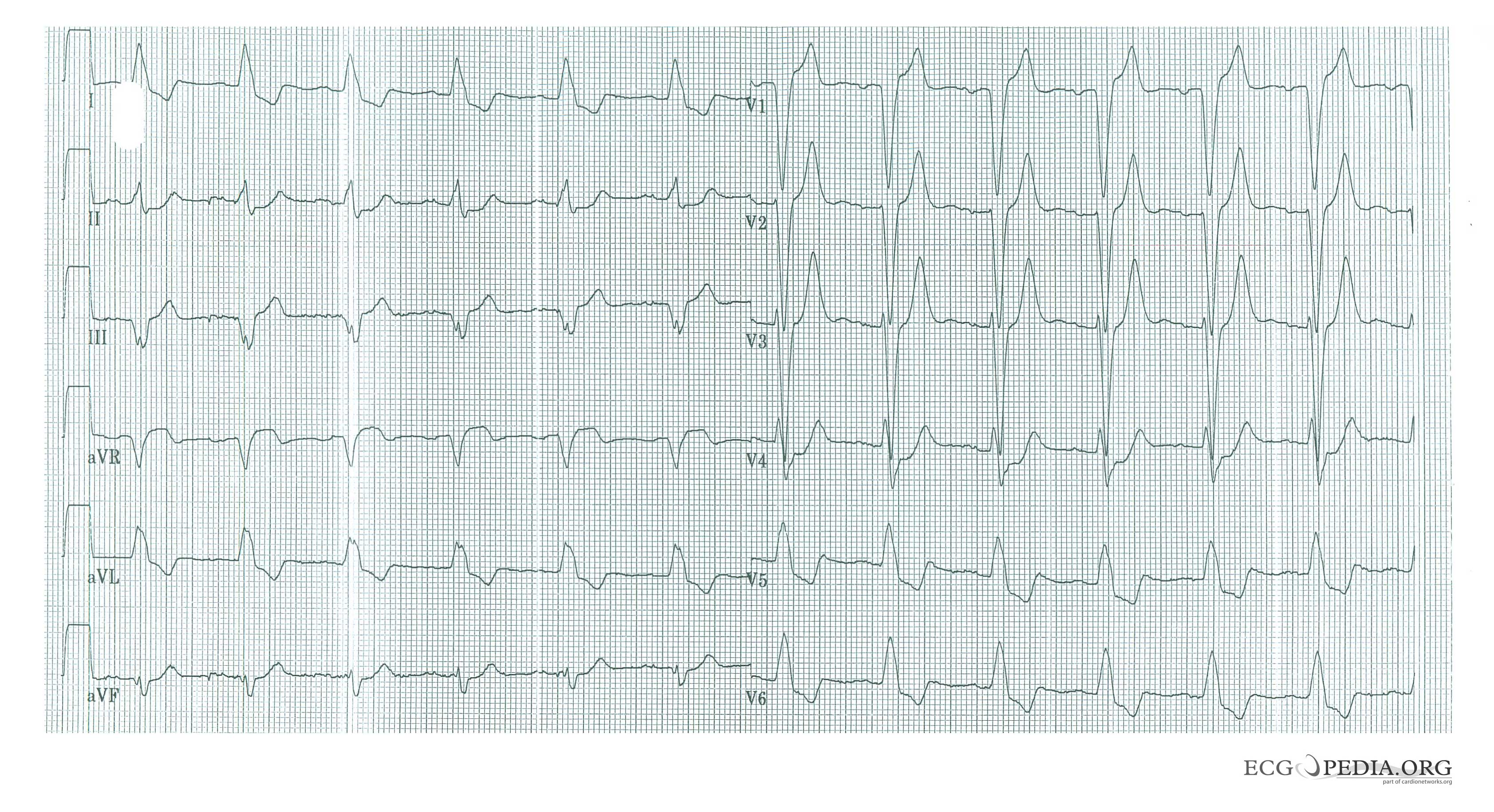
Copyleft image obtained courtesy of, http://en.ecgpedia.org/wiki/Main_Page
Shown below is an example of an EKG demonstrating Wellens' sign in proximal LAD lesion; characterized by symmetrical, often deep >2mm, T wave inversions in the anterior precordial lead; classically occurs during pain free period

Copyleft image obtained courtesy of,
Shown below is an example of an EKG demonstrating atrial fibrillation with inferior-posterior-lateral myocardial infarction and incomplete right bundle branch block. Lead I shows ST depression, suggestive of right coronary artery involvement.

Copyleft image obtained courtesy of, http://en.ecgpedia.org/wiki/Main_Page
Shown below is an example of an EKG demonstrating typical negative T waves post anterior myocardial infarction. This patient also shows QTc prolongation. Whether this has an effect on prognosis is debated. [1][2][3]
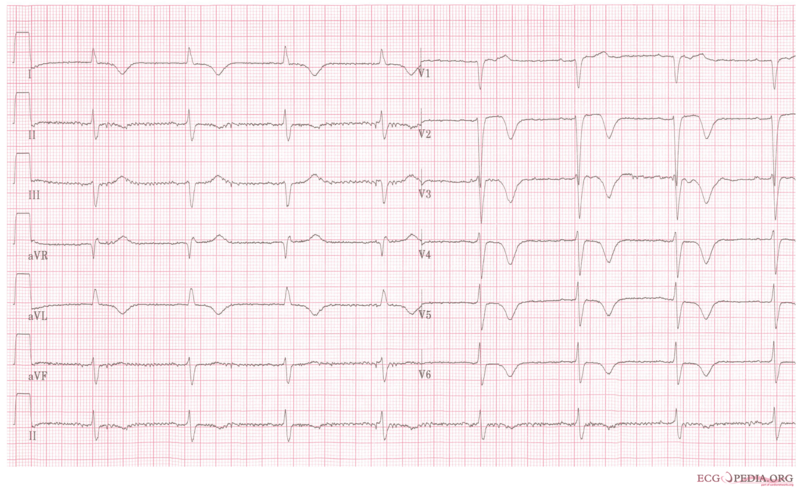
Copyleft image obtained courtesy of, http://en.ecgpedia.org/wiki/Main_Page
Shown below is an example of EKG showing ST elevation MI.
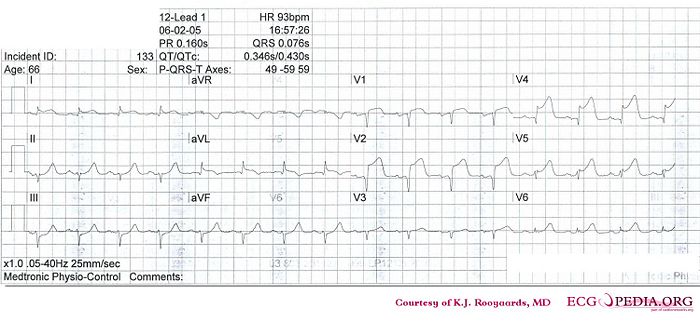
Copyleft image obtained courtesy of, http://en.ecgpedia.org/wiki/File:De-KJcasus12.jpg
Shown below is an example of EKG showing ST elevation in inferior leads.
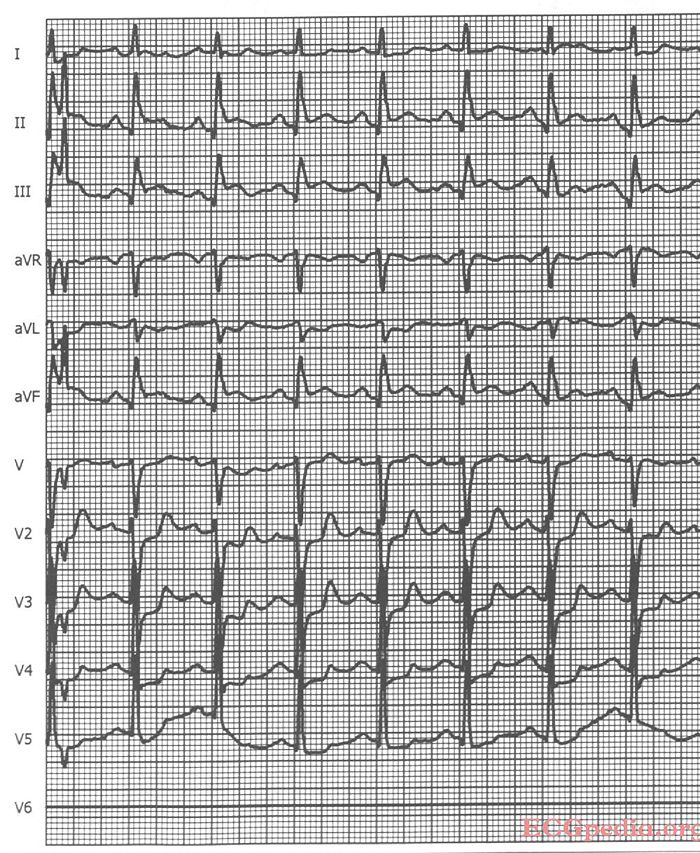
Copyleft image obtained courtesy of,
Shown below is an example of EKG showing ST elevation MI.
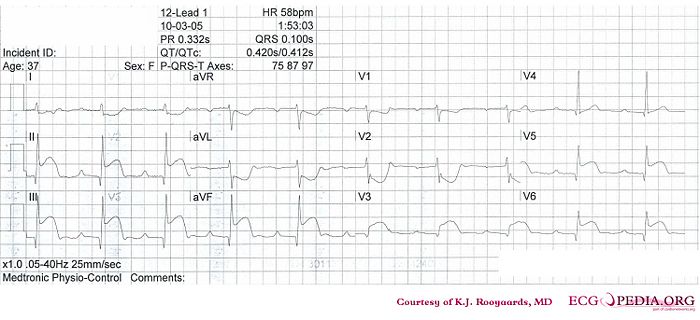
Copyleft image obtained courtesy of, http://en.ecgpedia.org/wiki/File:De-KJcasus13.jpg
Shown below is an example of EKG showing ST elevation MI.

Copyleft image obtained courtesy of, http://en.ecgpedia.org/wiki/File:De-KJcasus16.jpg
Shown below is an example of EKG showing ST elevation in inferior leads.
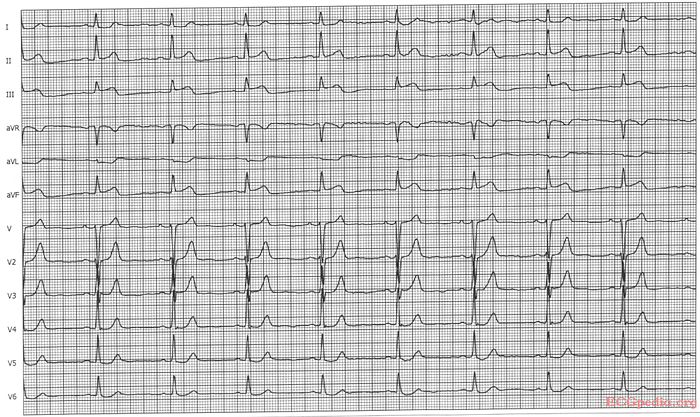
Copyleft image obtained courtesy of, http://en.ecgpedia.org/wiki/File:De-Ami0011.jpg
Shown below is an example of EKG showing ST elevation MI.

Copyleft image obtained courtesy of, http://en.ecgpedia.org/wiki/File:De-Ami0010.jpg
Shown below is an example of an EKG showing ST elevation in the anterior precordial leads, low voltages in all the leads, poor R wave progression in the precordial leads.
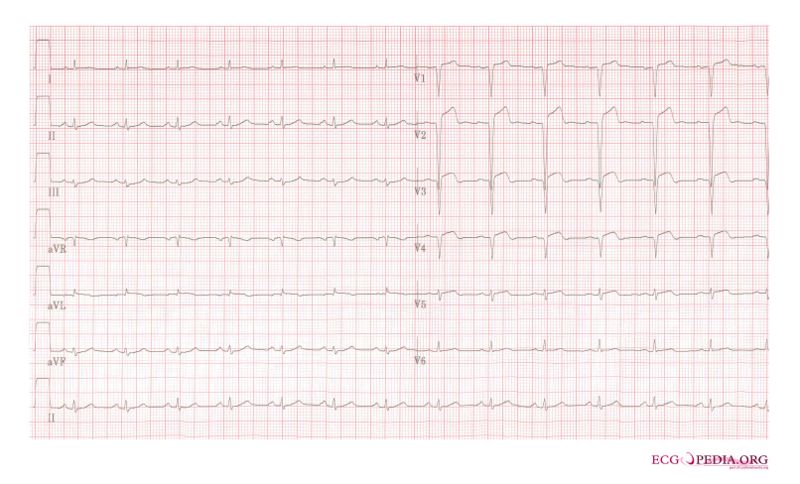
Copyleft image obtained courtesy of,
Shown below is an example of EKG demonstrating ST segment elevation in precordial leads signifying anterior myocardial infarction.
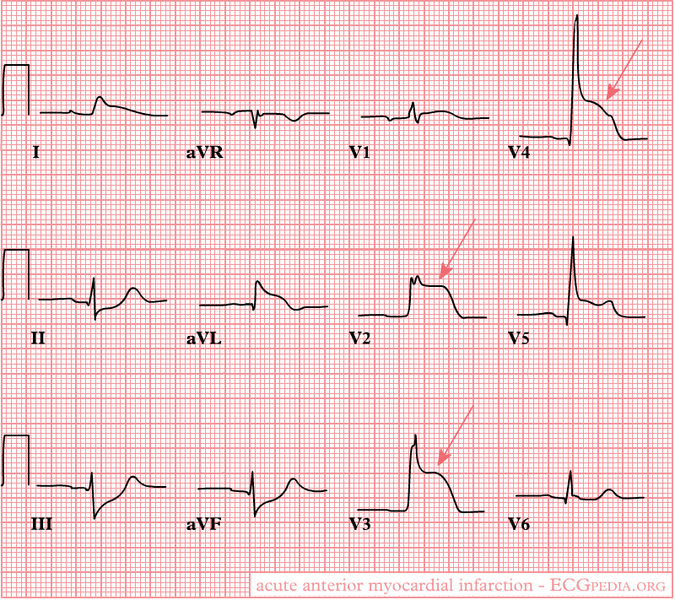
Copyleft image obtained courtesy of,
Shown below is an example of an EKG showing sinus rhythm with abnormal QRS and a Q wave in lead V2 which is suggestive of a previous anterior wall myocardial infarction.

Copyleft image obtained courtesy of,
The EKG below shows sinus rhythm. The QRS shows Q waves in the inferior leads which are wide (>30ms) and about 25% of the QRS height in aVF. There is also slight ST elevation in the inferior leads and T wave inversion. The EKG suggests an inferior wall infarction, probably old. (the best way to determine "old" is to see a previous cardiogram).

Copyleft image obtained courtesy of,
The EKG below shows sinus rhythm and a QRS with a rightward axis, as well as wide Q waves in leads I and AVL as well as a poor r wave progression across the anterior chest leads. There is also slight ST elevation in leads I, aVL, and T wave inversion in the lateral leads. The EKG is consistent with a lateral wall myocardial infarction. The patient had had a myocardial infarction a few months before. This event was associated with a cardiac arrest due to ventricular fibrillation which was successfully treated by the 911 ambulance service.

Copyleft image obtained courtesy of,
References
- ↑ Novotný T, Sisáková M, Floriánová A; et al. (2007). "[QT dynamicity in risk stratification in patients after myocardial infarction]". Vnitr Lek (in Czech). 53 (9): 964–7. PMID 18019666. Unknown parameter
|month=ignored (help) - ↑ Jensen BT, Abildstrom SZ, Larroude CE; et al. (2005). "QT dynamics in risk stratification after myocardial infarction". Heart Rhythm. 2 (4): 357–64. doi:10.1016/j.hrthm.2004.12.028. PMID 15851335. Unknown parameter
|month=ignored (help) - ↑ Chevalier P, Burri H, Adeleine P; et al. (2003). "QT dynamicity and sudden death after myocardial infarction: results of a long-term follow-up study". J. Cardiovasc. Electrophysiol. 14 (3): 227–33. PMID 12716101. Unknown parameter
|month=ignored (help)